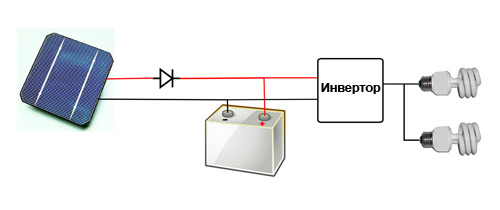Photoelectric inverter – the very heart of the installation
As we already mentioned, the solar energy converter is responsible for converting the energy from photovoltaic modules to alternating current with parameters identical to those found in a low-voltage power network, that is, 230/400 V 50 Hz. However, this is not all. An additional task of this device is to manage the process and collect statistics on energy production. One of the elements in this system is that devices track the maximum units of the work point, MPPT. The service life of a solar inverter is less than that of solar panels, which can work up to 25 years. It is assumed that – depending on the model and brand – their service life is from 8 to 12 years. There are microinverters on the market that can be used even up to 25 years.
Network inverter is installed when assembling solar panels. It is usually located near the panels, it is mounted vertically, and its connections are located on the bottom of the device.

Depending on the distance at which it is located, it can lead to a performance loss of up to 5%. This can be slightly compensated by conductors of appropriate quality that can provide less energy loss.
MPPT – what is it?
The art of assembling a photovoltaic installation suggests that each module that creates a chain of cells must be the same. This means that the combined photovoltaic panels must be of the same manufacturer, have the same nominal power and be of the same type. However, this is not all. Each panel should also have the same location, slope. All these requirements are important because only then can we be sure that the MPPT tracking system will be used optimally.
How does the MPPT system work? In a large simplification, this allows increasing the amount of energy received to a few to ten percent. How does this happen? It is quite simple. Modules available on the market do not have a fixed maximum power point, it is variable and dependent on radiation. This system tracks where such a point is (MPP maximum power point) and adapts to its new value. Because of this, we get higher energy yields. Currently, every modern converter has at least one such system.
Inverter for photovoltaic panels – types
Different types of inverters are available in the market. We will distinguish among them:
– single-phase and three-phase – low power in case of high demand for three-phase solutions are used. However, if you have a single-phase low-power inverter and three-phase low-power inverters, consider the second one, because it can significantly affect the stability of the local network, lead to less voltage fluctuations and also require smaller conductor sections;

– without a transformer and with a transformer – if it is necessary to ground one of the poles of the installation, contact an inverter with a transformer, since it provides galvanic isolation between the constant input voltage and the power supply network. However, if we do not need to use the galvanic isolation provided by the transformer, we can choose transformer solutions that – although they are lighter and smaller – tend to be more expensive due to the protection systems used, but in the long run this is a good choice;
– chain or central-chain converters can work with several series of modules, and are designed for installations with different sizes of lower power. Central inverters are designed for large solar farms and are unlikely to be used at home;
– network inverters – they are divided into two types, depending on whether they are connected to the network or not. The island inverter does not synchronize with the network, so it cannot give it energy, but it is able to charge batteries in case of surplus. The mains inverter allows you to synchronize with the public network, but the batteries cannot be charged.


